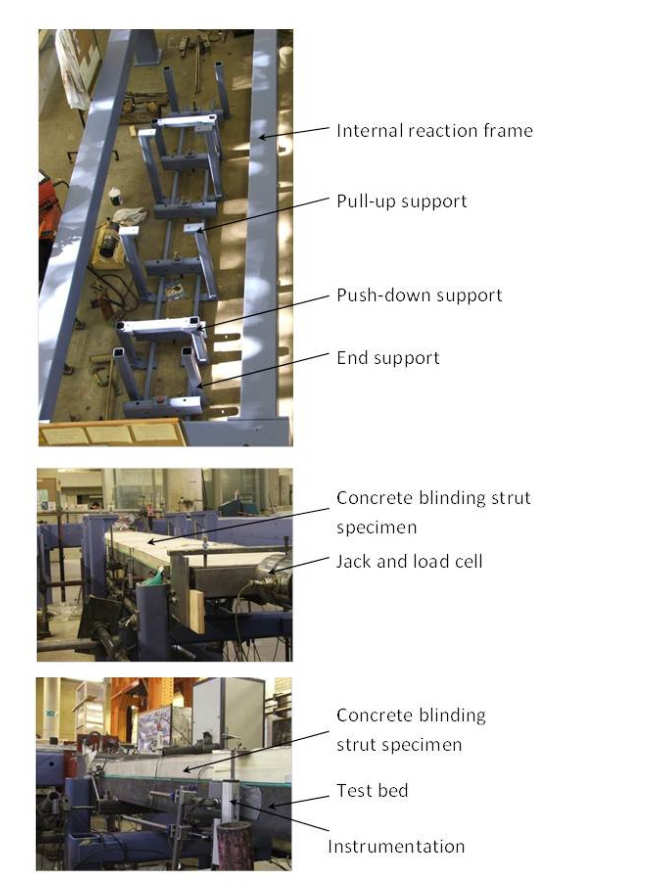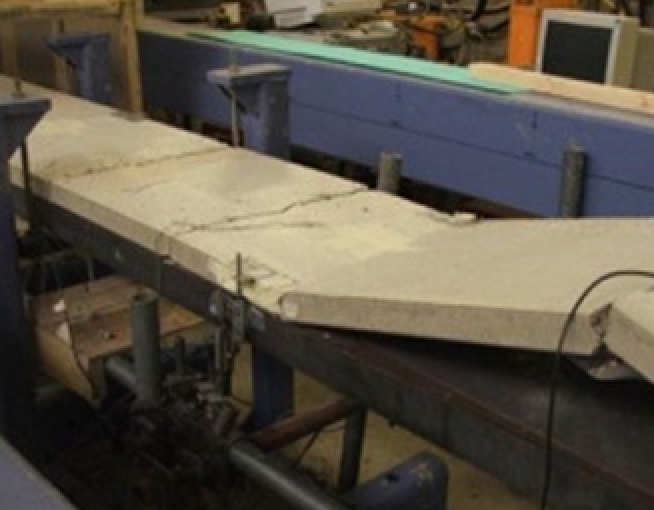Research team: Dr Robert Vollum, Prof. Bassam Izzuddin, Prof. Dave Potts and Dr Jeanette Abela (PhD researcher)
Funding: This project was funded by EPSRC under grant EP/D505488/1
Background

The term ‘blinding’ is used to describe the thin layer of unreinforced over-site concrete which is used to protect the base of excavations from construction traffic and provide a clean surface for the construction of the base slab. Blinding is not generally seen or exploited as a structural element even though it clearly provides some temporary lateral support to the retaining walls of cut-and-cover excavations.
This work was motivated by Powderham’s (2002) pioneering use of enhanced blinding as struts on major infrastructure projects such as the Channel Tunnel, Limehouse Link and the Heathrow Cofferdam which allowed much of the intermediate steel strutting, which would otherwise have been required, to be eliminated. This in turn created a safer working environment which enabled these projects to be completed several months before scheduled with considerable savings in cost and materials. Despite their evident advantages, however, blinding struts have not been widely used in practice.
The principle aims of the research were first to develop a scientific understanding of the failure mechanisms of blinding struts through carefully controlled experiments and numerical studies and second to develop a design oriented analytical model. The research1-10 showed that relatively thin blinding struts have significantly greater axial resistance than commonly supposed before failing in upheaval buckling, allowing considerable economies to be achieved in design. It validates the assumptions made on major infrastructure projects engineered by Mott MacDonald, including Channel Tunnel, Limehouse Link and the Heathrow Cofferdam. This provides a rational for clients to sanction the use of blinding struts since their behaviour is now considered more certain and definitively established.
Context and methodology

The research involved a synthesis of laboratory experiments, structural and geotechnical numerical modelling as well analytical studies of upheaval buckling. A series of twelve ¼ scale blinding struts were tested to failure under both short and long term loading on the test bed shown in Figure 1. The tested specimens measured 5m long by 500mm wide with thicknesses varying between 50mm and 68mm. The slabs were cast with geometrical imperfection amplitudes of either 6.25mm or 8.8mm and failed suddenly in upheaval buckling with the slab breaking up into a number of pieces as shown in Figure 2.
The research resulted in the development of a numerical method for predicting the response of blinding struts in cut and cover excavations that was calibrated with data from laboratory tests. Predicting the failure loads of blinding struts is complex since the buckling load depends on factors including cracking, creep, shrinkage and the rates at which the lateral and transverse loadings are introduced into the slab relative to the development of concrete strength.
This problem was solved by carrying out a coupled analysis using both geotechnical and structural finite element programs. The research showed that blinding struts can be highly effective as struts in cut and cover excavations. A simplified design method was developed for determining the axial capacity of concrete blinding struts in cut and cover excavations, which combines safety and economy. The model was validated with numerical analysis, and laboratory testing of 1/4 scale blinding struts.
Outputs
PhD thesis
- Abela, J. M., Blinding struts in cut and cover excavations, PhD thesis, University of London, 2009.
Journal articles
- Abela J. M., Vollum R. L., Izzuddin B. A., Potts D. M.,“Upheaval buckling behaviour of blinding struts”, The Structural Engineer, 86, (2008) 27-29.
- Abela, J.M., Vollum, R.L., Izzuddin, B.A. and Potts, D.M., Blinding Struts – Part 1: Buckling Response, Engineering Structures 33, Issue 9, (2011) 2563-2572
- Vollum, R.L., Izzuddin, B.A. Abela, J.M., & Potts, D.M., Blinding Struts – Part 2: Towards A Simplified Design Method, Engineering Structures, 33, Issue 9, (2011) 2573-2583
- Abela JM, Vollum RL, Izzuddin BA, et al, Blinding Struts under Long-Term Loading, Magazine of Concrete Research, 64, (2012), 1123-1134.
- Abela JM, Potts DM, Vollum RL, et al, Geotechnical analysis of blinding struts in cut-and-cover excavations, Computers and Geotechnics, (2013), 48, 179-191
Conference proceedings
- Abela J. M., Vollum R. L., Izzuddin B. A. and Potts D. M., "Upheaval buckling of blinding struts“, Concrete Communication Symposium Sheffield, 2007.
- Abela J. M., Vollum R. L., Izzuddin B. A. and Potts D. M., "Buckling of blinding struts in cut and cover excavations", Civil-Comp 2007 & AI Civil-Comp 2007 (Malta), (Proceedings of The eleventh international conference on civil, structural and environmental engineering computing, edited by: B.H.V. Topping, 2007).
- Abela J. M., Vollum R. L., Izzuddin B. A. and Potts D. M., "Short- and long-term effects on upheaval buckling of blinding struts”, 17th Conference of IABSE, Chicago, 2008.
- Abela J. M., Vollum R. L., Izzuddin B. A., Potts D., "Blinding struts in upheaval buckling”, fib London 2009, 2009
Contact Structures
Structures
Civil and Environmental Engineering
Skempton Building
Imperial College London
South Kensington Campus
London, SW7 2AZ
Telephone:
+44(0) 207 594 6040
Email: r.bello@imperial.ac.uk
Alternatively view our people lists
We are located in the Skempton Building (building number 27 on the South Kensington Campus Map). How to find us